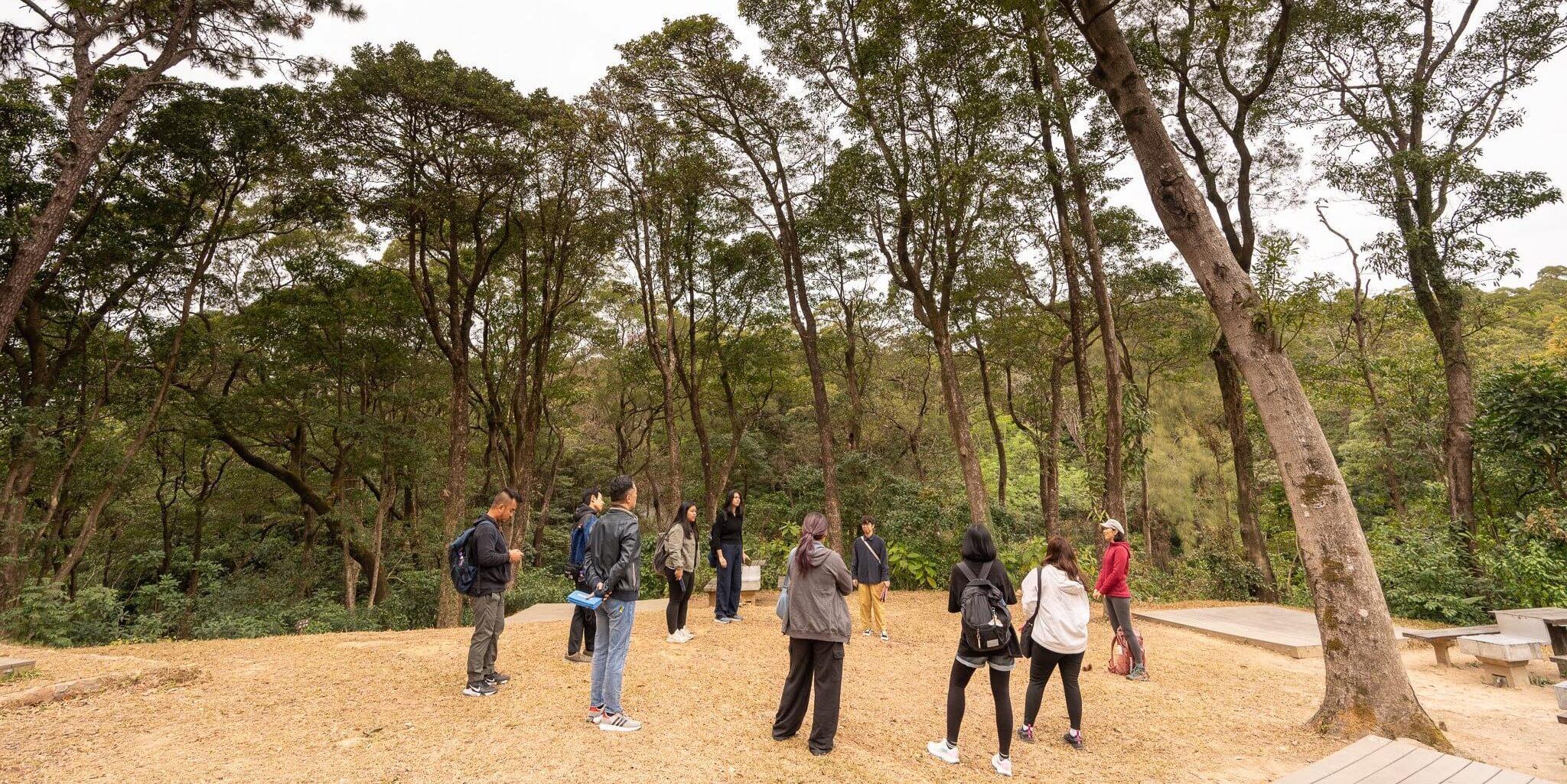Forest bathing 101: Slow walks on trails, befriending trees, and reconnecting with nature for better mental well-being

For Metro Manila residents and the quintessential homebody or taong-bahay, an inaccurate image might come to mind when hearing about forest bathing for the first time.
On a familiarization trip organized by the Hong Kong Tourism Board last January, we learned firsthand that it does not actually mean to literally bathe in a forest.
Amanda Yik, a certified nature and forest therapy guide and the founder of Shinrin Yoku Hong Kong, said this practice originated in Japan in the 1980s. According to Amanda, shinrin-yoku, which translates to "forest bathing," was introduced as a well-being initiative for Japanese people affected by stress-related symptoms to help them relax and rejuvenate.
Developed by the Forest Agency of Japan, forest bathing encouraged the public to reconnect with nature in a way that was accessible and gave them an alternative to slow down amid their busy lifestyles during a time of technological revolution in the country.
Forest bathing isn't really the same as hiking and it would be inaccurate to say it's a nature walk, either. The practice, which follows no fixed rules, involves immersing oneself in the outdoors while engaging all of the senses to ground oneself, be present, and simply be. While this can involve walking in a forest, it is not physically strenuous nor challenging, nor does it require one to reach a certain point or destination.
The wonders and benefits of forest bathing were not meant to be kept a secret, as the practice has since caught on around the world. In the Philippines, there are some organizations that offer forest bathing experiences, such as Forest Bathing MNL and Eco Explorations, to name a few, while the Department of Environment and Natural Resources is set to develop a forest bathing area and sensory garden at the Ninoy Aquino Parks and Wildlife Center in Quezon City.
In Hong Kong, forest bathing is a lot more popular these days than when Amanda first started some seven years ago.
"I think the Covid pandemic kind of pushed people towards [understanding] more about mental well-being, taking care of ourselves beyond just going to see a doctor and just doing things on a daily basis or more kind of a casual basis to boost our immune system, boost our health. There is much more awareness, definitely," she said.
Amanda added people are seeing forest bathing as more of a well-being practice that they incorporate into their lives than a one-off thing.
Its participants comprise people of all sorts and ages, noting that she often gets "stressed-out adults, like 30 to 50-ish, the middle age."
"'Cause this is the stress age. You've got work and family and you've got all the people to take care of, all the pressures, but also increasingly [there are] students, teenagers, university students who are very stressed. There's a lot of mental health challenges, so sometimes it's the universities or the college who organize these experiences and they're open to the students."
It is also a suitable, low-impact practice for the elderly especially when one's mobility is challenged.
This rang true during our forest bathing experience one Tuesday in Tai Mo Shan Country Park, the highest peak in Hong Kong, as well as the nearby Tai Lam Country Park. Even on a weekday, there were a couple of adult campers who had set up tents in the area, and a large group of young students also went on the Twisk Nature Trail ahead of us for a day trip.
Here's what happened during our forest bathing experience.
A series of intentional invitations – and a leaf microphone
According to Amanda, sharing and connecting with one another are important components of forest bathing, although these are also invitational, much to the relief of the introverts in the group. Nevertheless, she presented us with a leaf as a makeshift microphone to share our observations throughout the experience.
Before entering the Twisk Nature Trail, we sat on the grass and closed our eyes, not so much to meditate but just to "sense into the body" as a whole. Forest bathing takes away whatever pressure there is in sharing; one's observations do not have to be anything profound, these can be small and insignificant. With the body as "a radar," one is prodded to notice the motions and sensations in the surroundings. The grass was itchy, the plane that hovered above annoyingly loud.
Still, there was a certain calm to the experience: You could hear the birds and feel the light breeze on your face. One is aware of the rhythmic breathing of the person right next to them, the rise and fall of their chest. As we stood up and made our way towards the trail, we were encouraged to observe the body's own sensations and sensitivities.
Befriending a tree, walking backwards
We walked slowly through the Twisk Campsite, taking in the surroundings such as the pine trees, the stones on the rugged path, the sounds of the leaves rustling, and the birds.
Past the tents, we settled in a tranquil area of the campsite surrounded by trees and shrubbery. Amanda encouraged us to "befriend a tree," sort of like picking out your person at a party.
"Wander around and, focusing on the trees, see if there's a tree that you feel like that person in a party. If I approach this tree, it might be quite nice. This tree might welcome me, so just sense into that, again using your body as a radar. There's no one going to tell you that tree doesn't want to see you," she said.
We took our time walking around, eyeing the trees up and down. As the group found their respective trees, we sat next to our tree to share a silent moment. It was “quite nice” but one might feel a bit self-conscious in this activity, if only for the novelty of it, because how often do city people look for a tree to befriend?
The group had to move on eventually and we said our personal goodbyes to our trees. We slowly walked our way up an uphill road and Amanda invited us to try and walk backwards with a buddy.
The experience jolts you somewhat; careful not to fall, we teetered and swayed backwards as we tried to keep our balance and engage unfamiliar muscles. It was much harder than we thought.
A necessary reset
We ended the forest bathing experience at a little spot around the Tai Lam Forest Track. We watched Amanda unfurl a mat on a table, assembling tea cups in half-moon formation and plating a small serving of dried mushrooms and candies.
She asked us, once more, to pick up things around the area that we can decorate our humble spread with and we returned with leaves, rocks, twigs, and acorns that we arranged around the tea cups. The forest bathing was over, and as we drank tea and munched on the snacks, it was almost hard to believe we had spent two hours immersing ourselves in the natural environment.
Throughout the familiarization trip, we explored Hong Kong's great outdoors and wellness spots, which included walking the High Island Geo Trail in Sai Kung, cycling at Plover Cove Reservoir Dam, and hiking the Dragon's Back – activities that tested the mettle of our physicality.
Forest bathing, on the other hand, encouraged us to disengage from the algorithmic grind of daily life in a slow and mindful way. It provided the necessary physical and mental reset that we needed in just one session.
It reflects a 2019 study on the Environmental Health and Preventive Medicine journal that shows a single two-hour session of forest bathing can help improve the physiological and psychological health of those who are of working age. Participants who went forest bathing exhibited a decrease in blood pressure and improved mood. Even more, the improvement in mood states was greater among those with depressive tendencies. Indeed, the experience left us feeling renewed, calm, and eager to do it again one day.
When in Hong Kong, there is really no dearth of things to do as far as its magnificent outdoors and wellness scene are concerned. Choose the one that you feel ready for, you're spoiled for choice.
This story was produced with support from the Hong Kong Tourism Board.
— LA, GMA Integrated News

Need a wellness break? Sign up for The Boost!
Stay up-to-date with the latest health and wellness reads.
Please enter a valid email address
Your email is safe with us






